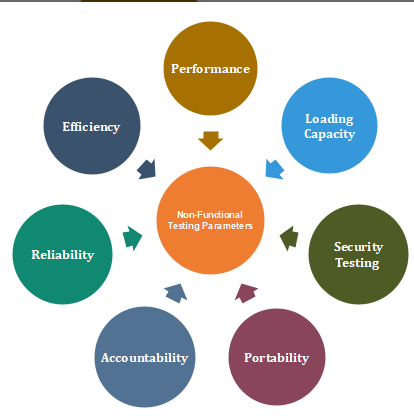| Usama Muhammad
What is Non-Functional Testing?
It is a type of software testing to test the non-functional parameters like performance, load
test, reliability, security, portability, flexibility, reusability, etc. The main purpose of the
non-functional testing is to check how much the software is relatable to the User Experience
goals, the readiness of the software, the speed of the software.
Non-functional testing cannot start before the functional testing.
Non-functional testing is very important in the software testing because it plays a crucial role
in the customer satisfaction.
The best and the simplest example of non-functional testing is to check how many users/customers
can work on software or application simultaneously.
How much users or requests can software respond at a time.
Objectives of Non-Functional Testing:
- Collect and Produce measurements, and metrics for internal research and development
- Improve and Enhance the Knowledge of product behavior and technologies in use
- Non-functional testing should increase the usability, efficiency, portability and performance of the product
- The purpose is to cover the testing of all the characteristics of the application which help to provide an application that meets the business expectation
- Enough efforts should be made to develop a software system
- Helps to reduce production risk and cost associated with non-functional aspects of the product
- Ensure that quality attributes are identified correctly in Software Engineering
Parameters of Non-Functional Testing:

- Performance Testing: The purpose of this testing is to check how the software response. It eliminates the reason behind the slow and limited performance of the software. For Performance testing, a well-structured and clear specification must be defined. Otherwise, the result of the test is not obvious either it is pass or fail.
- Load Testing: Load testing is performing to check that how much load can software beard in a specified and limited time. To check how that more users or requests can endure in a specified capacity or not.
- Efficiency: The purpose of this testing is to check how much the system or software or application is efficient according to current user experience specification. How much efficiently used in the market or some specified environment.
- Security Testing: Security testing is used to detect the security flaws of the software application. The testing is done via investigating system architecture and the mindset of an attacker. Test cases are conducted by finding areas of code where an attack is most likely to happen. It is mandatory to check how much user data secured in the implemented software. If any software or application doesn’t give security of the data then it is useless in the entire world.
- Reliability: Reliability test assumes that whether the software system is running without fail under specified conditions or not. The system must be run for a specific time and number of processes. If the system is failed under these specified conditions, reliability test will be failed.
- Portability: The basic purpose of this testing is to ensure that the software is running on different operating systems or running on different machines. This type of testing to check how much the software is portable either it is working same in different environments or not.
- Accountability: Accountability test is done to check whether the system is operating correctly or not. A function should give the same result for which it has been created. If the system gives expected output, it gets passed in the test otherwise failed.
Key Differences Between Functional & Non-Functional Testing:
- Non-functional requirements is based on the developers and technical knowledge of the team whereas Functional requirements is based on Customer Needs.
- Non-Functional testing is hard to perform manually whereas Functional testing can be done manually.
- Non-Functional testing has a goal to validate the performance of the software whereas Functional testing has a goal to validate software actions.
- Non-Functional testing has a goal to validate the performance of the software whereas Functional Requirement specifies which functionality to be taken into consideration i.e. what needs to be tested.
- Implementation Plan of Non-functional requirements is defined in system architecture whereas Functional Testing requirements in defined in system design document.
Learn more about Imperium's Power App Services. We hope this information was useful, and we look forward to sharing more insights into the Power Platform world.

